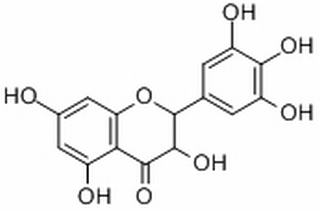Home
Products
Ampelopsin



| Product Name | Ampelopsin |
| Price: | $15 / 20mg |
| Catalog No.: | CN05430 |
| CAS No.: | 27200-12-0 |
| Molecular Formula: | C15H12O8 |
| Molecular Weight: | 320.3 g/mol |
| Purity: | >=98% |
| Type of Compound: | Flavonoids |
| Physical Desc.: | Powder |
| Source: | The herbs of Myrica rubra (Lour.) Zucc. |
| Solvent: | Chloroform, Dichloromethane, Ethyl Acetate, DMSO, Acetone, etc. |
| SMILES: | Oc1cc2O[C@H](c3cc(O)c(c(c3)O)O)[C@H](C(=O)c2c(c1)O)O |
| Contact us | |
|---|---|
| First Name: | |
| Last Name: | |
| E-mail: | |
| Question: | |
| Description | Dihydromyricetin is a potent inhibitor with an IC50 of 48 μM on dihydropyrimidinase. Dihydromyricetin can activate autophagy through inhibiting mTOR signaling. Dihydromyricetin suppresses the formation of mTOR complexes (mTORC1/2). |
| Target | Dihydropyrimidinase:48 μM (IC50) mTORC1 mTORC2 Autophagy |
| In Vitro | Dihydromyricetin, a flavonol, significantly inhibits the catalytic activities of dihydropyrimidinase toward both the natural substrate dihydrouracil and xenobiotic substrate 5-propyl-hydantoin. Dihydromyricetin exhibits a significant inhibitory effect on the activities of dihydropyrimidinase for both substrates, even more than Myricetin does. The IC50 values of Dihydromyricetin for dihydropyrimidinase determined from the titration curves using Dihydrouracil and 5-propyl-hydantoin are 48±2 and 40±2 μM, respectively[1]. Dihydromyricetin (DHM) supplementation significantly reverses the increased phosphorylation of mTOR at Ser2448 (p-mTOR) during D-gal administration, which suggests that Dihydromyricetin can activate autophagy through inhibiting mTOR signaling[2]. |
| In Vivo | Changes in learning and memory capacity in rats administrated normal control group, D-gal group, D-gal+Dihydromyricetin (100 mg/kg) group, D-gal+Dihydromyricetin (200 mg/kg) group assessed by morris water maze (MWM) (n=10 per group). Dihydromyricetin (DHM) treatment significantly shortens the escape latency when compared with D-gal-induced model group[2]. |
| Cell Assay | Hippocampus and cortex tissue samples are homogenized in lysis buffer containing 20 mM Tris (pH 7.5), 135 mM NaCl, 2 mM EDTA, 2 mM DTT, 25 mM β-glycerophosphate, 2 mM sodium pyrophosphate, 10% glycerol, 1% Triton X-100, 1 mM sodium orthovanadate, 10 mM NaF, 10 μg/mL aprotinin, 10 μg/mL leupeptin, and 1 mM PMSF for 30 min on ice and centrifuged at 12000×g at 4°C for 30 min. The supernatant is collected and protein quantification is carried out using a BCA kit. The protein samples are boiled in the presence of sample buffer at 95°C for 5 min. The target protein is separated by sodium dodecyl sulfate polyacrylamide gel electrophoresis (SDS-PAGE), transferred to nitrocellulose membrane, and then probed by corresponding primary and secondary antibodies. Finally, the target protein is visualized by enhanced chemiluminescence (ECL) reagent exposure to X-ray film[2]. |
| Animal Admin | Rats[2] Totally 40 male Sprague-Dawley (SD) rats (age: 8 weeks old; body weight: 160±20 g) are used. The rats are randomly divided into four groups including normal control group, D-gal model group, and D-gal combined with DHM at the doses of 100 and 200 mg/kg-d groups with 10 rats in each group. All rats are housed at the environment with room temperature of 22±2°C and a dark-light cycle (12 h: 12h), and provided the accessibility to food and water ad libitum. After adapting to new environment for 1 week, the rats from DHM groups are administered with DHM dissolved in distilled water at the designated dosages by gavage once a day at 8:00am for 6 consecutive weeks. The rats from the normal control group are administrated with distilled water. Except from the normal control group, the rats from other groups are subjected to subcutaneous injection of D-gal at the dose of 150 mg/kg.d for 6 consecutive weeks. Each administration of DHM should be 2 h ahead of D-gal injection. |
| Density | 1.8±0.1 g/cm3 |
| Boiling Point | 780.7±60.0 °C at 760 mmHg |
| Flash Point | 296.7±26.4 °C |
| Exact Mass | 320.053223 |
| PSA | 147.68000 |
| LogP | 1.23 |
| Vapour Pressure | 0.0±2.8 mmHg at 25°C |
| Storage condition | ?20°C |